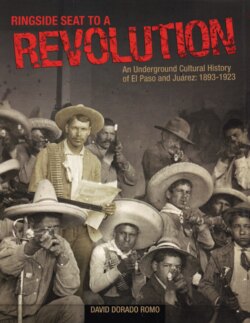Читать книгу Ringside Seat to a Revolution - David Dorado Romo - Страница 13
На сайте Литреса книга снята с продажи.
Оглавлениеhis favorite drink, and hang out with all kinds of char-
acters. One evening, he met with alleged German
secret agent Maximilian Kloss at the bar. Apparently,
the agent wanted to buy the rights to some submarine
bases in Baja California just in case Germany went to
war against the United States.
When I first walked inside the Roma Hotel as part
of my investigation, the first floor had been turned
into a grocery and the second floor was a rundown
tenement for farm workers. I wanted to show my old
photographs of Villa to the campesinos and ask if
anyone of them recognized this man.
They would probably think I was some
kind of undercover agent. Maybe they
would tell me that a man looking like
that used to live there but he had moved
a long time ago. No, they didn’t have his
new address.
A few months later in 2002, I came
back to snoop around some more, but
the Roma Hotel had been torn down to
make space for a Burger King. Pancho
Villa was definitely not there any more.
If I had been a detective looking for
Pancho Villa when he was hiding in El
Paso, I would have looked for him in
one of his wives’ houses. Everyone
knew Pancho was a real mujeriego. He
had a pad for Luz Corral on 608 Oregon
Street and another one for Soledad
Seañez just two blocks up on 816
Oregon, where she bore him a son. But
these homes too have been torn down.
Damn. How was I ever going to
find Pancho Villa if they kept demolish-
ing every building he’s ever been in?
AFTER A FEW months of walking through the city,
I realized my aimless wanderings had transformed
themselves into an obsessive, very focused manhunt.
I’d somehow entered a zone I couldn’t get out of.
Now if I went to a cemetery, it was no longer just
an aimless stroll. I went specifically to cast about for
Pancho Villa’s friends or enemies. I looked up
Victoriano Huerta’s grave at Evergreen Cemetery,
across from Chico’s Tacos on Alameda Street. I won-
dered whether the old military dictator was still pissed
off at Pancho for capturing Juárez in 1913 in the mid-
dle of the night with a brilliant Trojan Horse attack.
He was probably still muttering to himself—six
feet under the ground—the same thing he told the El
Paso newspapers nine decades ago. “Pouf! That man
is only a bandit, an ignorant peon. Es un inculto. Villa
can hardly spell his name. No. No. He’s incapable of
coming up with such a plan. It is too complicated for
him. He’s nothing but an ignorant brigand, a murder-
er. That’s all.”
I felt sorry for Huerta. The unwanted former pres-
ident of Mexico hasn’t drunk a drop of whiskey in
decades. I’m sure his throat is extremely dry.
I WALKED INTO the basement of the El Paso
Public Library downtown and lost myself there for
three or four years, reading every single newspaper
published in El Paso between 1893 and 1923.
I examined thousands of photographs and pored
through old maps. I had read some place that
Columbus spent several years poring over ancient
maps of the world before he set out across the ocean.
I found maps showing where old mines were located
in the area, but I wasn’t interested. What I was
prospecting for was much more valuable than any
precious metal.
While doing research for Discipline and Punish:
The Birth of the Prison, Michel Foucault uncovered
Jeremy Bentham’s architectural specifications for the
7
Colonel Pancho Villa (left) and General Pascual Orozco Jr.
(sitting at center) eat ice cream at El Paso’s Elite Confectionary, 1911.
(Aultman Collection, El Paso Public Library.)
